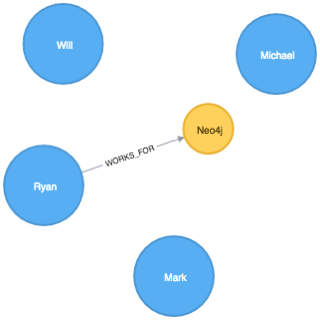Neo4j: How do null values even work?
Every now and then I find myself wanting to import a CSV file into Neo4j and I always get confused with how to handle the various null values that can lurk within.
Let’s start with an example that doesn’t have a CSV file in sight. Consider the following list and my attempt to only return null values:
WITH [null, "null", "", "Mark"] AS values
UNWIND values AS value
WITH value WHERE value = null
RETURN value
(no changes, no records)Hmm that’s weird. I’d have expected that at least keep the first value in the collection. What about if we do the inverse?
WITH [null, "null", "", "Mark"] AS values
UNWIND values AS value
WITH value WHERE value <> null
RETURN value
(no changes, no records)Still nothing! Let’s try returning the output of our comparisons rather than filtering rows:
WITH [null, "null", "", "Mark"] AS values
UNWIND values AS value
RETURN value = null AS outcome
╒═══════╤═════════╕
│"value"│"outcome"│
╞═══════╪═════════╡
│null │null │
├───────┼─────────┤
│"null" │null │
├───────┼─────────┤
│"" │null │
├───────┼─────────┤
│"Mark" │null │
└───────┴─────────┘Ok so that isn’t what we expected. Everything has an 'outcome' of 'null'! What about if we want to check whether the value is the string "Mark"?
WITH [null, "null", "", "Mark"] AS values
UNWIND values AS value
RETURN value = "Mark" AS outcome
╒═══════╤═════════╕
│"value"│"outcome"│
╞═══════╪═════════╡
│null │null │
├───────┼─────────┤
│"null" │false │
├───────┼─────────┤
│"" │false │
├───────┼─────────┤
│"Mark" │true │
└───────┴─────────┘From executing this query we learn that if one side of a comparison is null then the return value is always going to be null.
So how do we exclude a row if it’s null?
It turns out we have to use the 'is' keyword rather than using the equality operator. Let’s see what that looks like:
WITH [null, "null", "", "Mark"] AS values
UNWIND values AS value
WITH value WHERE value is null
RETURN value
╒═══════╕
│"value"│
╞═══════╡
│null │
└───────┘And the positive case:
WITH [null, "null", "", "Mark"] AS values
UNWIND values AS value
WITH value WHERE value is not null
RETURN value
╒═══════╕
│"value"│
╞═══════╡
│"null" │
├───────┤
│"" │
├───────┤
│"Mark" │
└───────┘What if we want to get rid of empty strings?
WITH [null, "null", "", "Mark"] AS values
UNWIND values AS value
WITH value WHERE value <> ""
RETURN value
╒═══════╕
│"value"│
╞═══════╡
│"null" │
├───────┤
│"Mark" │
└───────┘Interestingly that also gets rid of the null value which I hadn’t expected. But if we look for values matching the empty string:
WITH [null, "null", "", "Mark"] AS values
UNWIND values AS value
WITH value WHERE value = ""
RETURN value
╒═══════╕
│"value"│
╞═══════╡
│"" │
└───────┘It’s not there either! Hmm what’s going on here:
WITH [null, "null", "", "Mark"] AS values
UNWIND values AS value
RETURN value, value = "" AS isEmpty, value <> "" AS isNotEmpty
╒═══════╤═════════╤════════════╕
│"value"│"isEmpty"│"isNotEmpty"│
╞═══════╪═════════╪════════════╡
│null │null │null │
├───────┼─────────┼────────────┤
│"null" │false │true │
├───────┼─────────┼────────────┤
│"" │true │false │
├───────┼─────────┼────────────┤
│"Mark" │false │true │
└───────┴─────────┴────────────┘null values seem to get filtered out for every type of equality match unless we explicitly check that a value 'is null'.
So how do we use this knowledge when we’re parsing CSV files using Neo4j’s LOAD CSV tool?
Let’s say we have a CSV file that looks like this:
$ cat nulls.csv
name,company
"Mark",
"Michael",""
"Will",null
"Ryan","Neo4j"So none of the first three rows have a value for 'company'. I don’t have any value at all, Michael has an empty string, and Will has a null value. Let’s see how LOAD CSV interprets this:
load csv with headers from "file:///nulls.csv" AS row
RETURN row
╒═════════════════════════════════╕
│"row" │
╞═════════════════════════════════╡
│{"name":"Mark","company":null} │
├─────────────────────────────────┤
│{"name":"Michael","company":""} │
├─────────────────────────────────┤
│{"name":"Will","company":"null"} │
├─────────────────────────────────┤
│{"name":"Ryan","company":"Neo4j"}│
└─────────────────────────────────┘We’ve got the full sweep of all the combinations from above. We’d like to create a Person node for each row but only create a Company node and associated 'WORKS_FOR' relationshp if an actual company is defined - we don’t want to create a null company.
So we only want to create a company node and 'WORKS_FOR' relationship for the Ryan row.
The following query does the trick:
load csv with headers from "file:///nulls.csv" AS row
MERGE (p:Person {name: row.name})
WITH p, row
WHERE row.company <> "" AND row.company <> "null"
MERGE (c:Company {name: row.company})
MERGE (p)-[:WORKS_FOR]->(c)
Added 5 labels, created 5 nodes, set 5 properties, created 1 relationship, statement completed in 117 ms.And if we visualise what’s been created:

Perfect. Perhaps this behaviour is obvious but it always trips me up so hopefully it’ll be useful to someone else as well!
There’s also a section on the Neo4j developer pages describing even more null scenarios that’s worth checking out.
About the author
I'm currently working on short form content at ClickHouse. I publish short 5 minute videos showing how to solve data problems on YouTube @LearnDataWithMark. I previously worked on graph analytics at Neo4j, where I also co-authored the O'Reilly Graph Algorithms Book with Amy Hodler.
